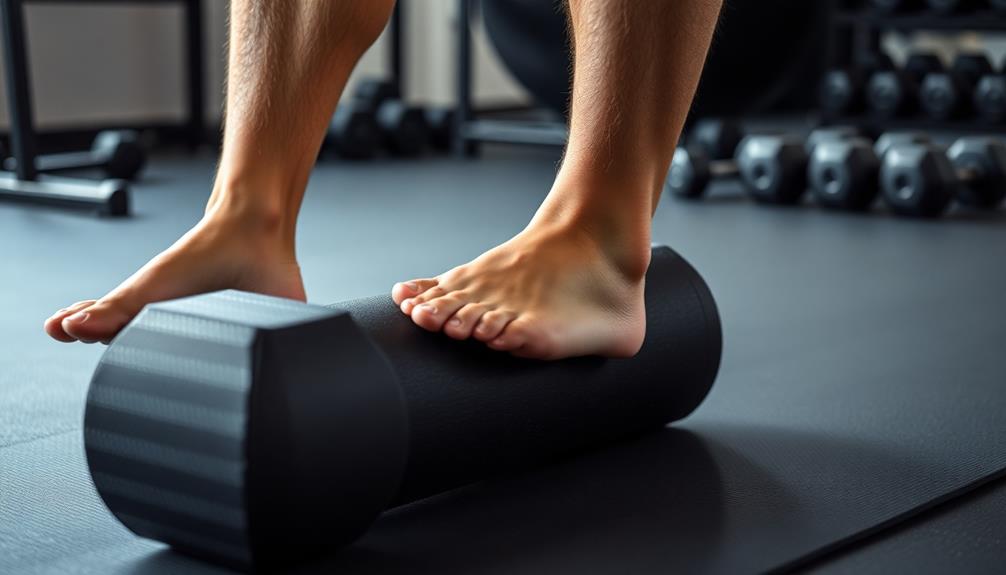After leg day, foam rolling is essential for recovery. Focus on your quadriceps, hamstrings, calves, IT band, and glutes. Don't forget your adductors, shins, lower back, and hip flexors. Start with your quads, lying face down and rolling from hips to knees. For hamstrings, sit and roll from glutes to knees. Target your calves and Achilles tendon by rolling from ankles to knees. The IT band requires side-lying and rolling along the outer thigh. For glutes, sit and cross one ankle over the opposite knee. Remember to pause on sore spots for 20-30 seconds. These techniques will help reduce muscle soreness and improve flexibility. Discover more ways to enhance your post-workout recovery routine.
Core Insight
- Quadriceps roll targets thigh muscles, relieving soreness from squats and lunges.
- Hamstring release helps alleviate tightness in the back of the thighs after leg exercises.
- Calf and Achilles tendon rolling reduces tension from high-impact leg workouts.
- IT band technique addresses outer thigh tightness common after leg day activities.
- Glute targeting helps release tension in the buttocks, crucial for post-leg day recovery.
Quadriceps Roll
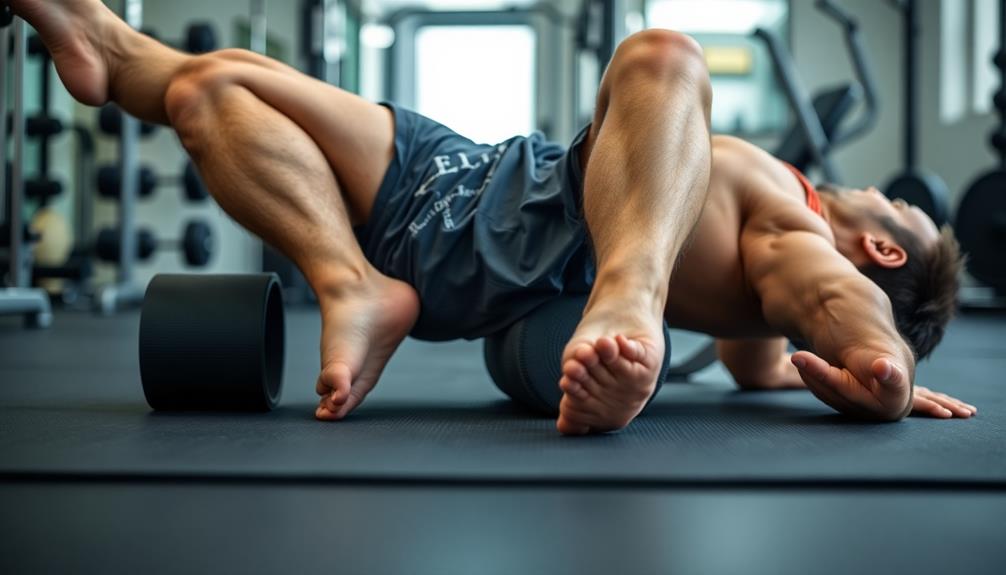
After a tough leg workout, your quads might feel sore and tight. The quadriceps roll is a great way to help with this. A firm foam roller can massage your muscles and make knots feel better. Here's what to do:
- Lie on your stomach with the foam roller under your thighs.
- Use your forearms to hold yourself up.
- Roll slowly from your hips to just past your knees.
- When you find a sore spot, stop and hold for 20-30 seconds.
- Keep rolling each leg for 1-2 minutes.
For more pressure, cross one leg over the other. Breathe deeply and relax as you roll. If it hurts too much, use less pressure or talk to an expert. Using a foam roller often can help your muscles recover and be more flexible after leg day.
Hamstring Release

Hamstring Release
Tight hamstrings are common after leg day. To release them, sit on a foam roller with your legs straight out in front. Put your hands on the ground behind you for support. Lift your hips a bit and roll from right below your glutes to the backs of your knees. A high-density foam roller can massage deeper and release the muscle better.
For a more focused approach, cross one leg over the other and roll the bottom leg's hamstring. Pause on sore spots for 20-30 seconds to release tension. Breathe deeply and relax as you stretch.
If it's too painful, put more weight on your hands to reduce pressure. Spend about 1-2 minutes on each leg and adjust the intensity as needed.
Calves and Achilles Tendon
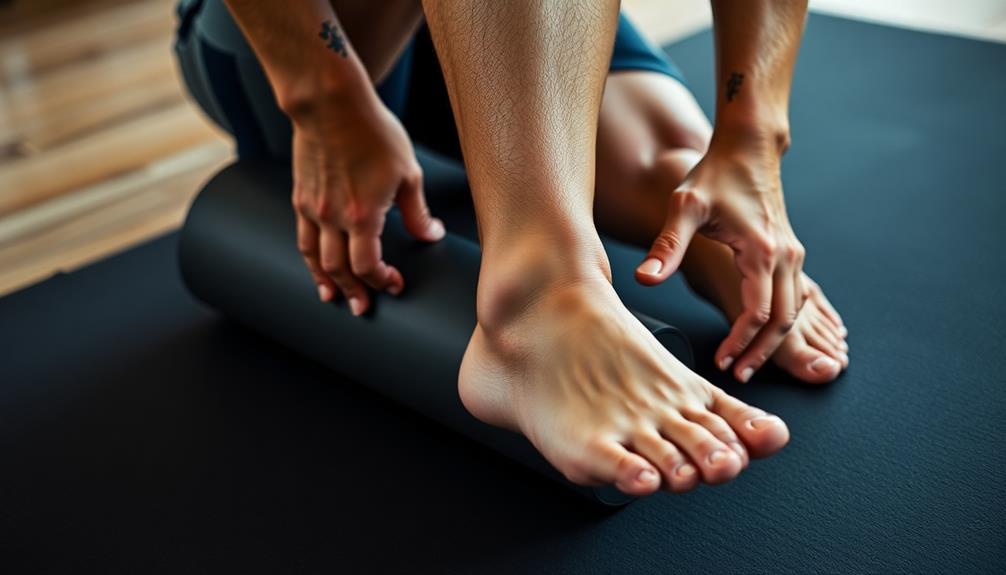
Your calves and Achilles tendon are small but mighty. They help you walk, run, and move around. To use a foam roller on them, sit on the floor with your legs out straight. Put the roller under your calves and lift your hips. Roll slowly from your ankles to just below your knees. Pause on any tight spots. A firm foam roller can give you a deep massage and help your muscles recover.
For your Achilles tendon, put the roller at the bottom of your calf, just above your ankle. Press gently and move the roller back and forth. Don't roll right on the tendon, but focus on the area around it. Spend about 30-60 seconds on each leg. Be careful not to do too much on these sensitive areas. Breathe deeply and relax your muscles for the best results.
IT Band Technique
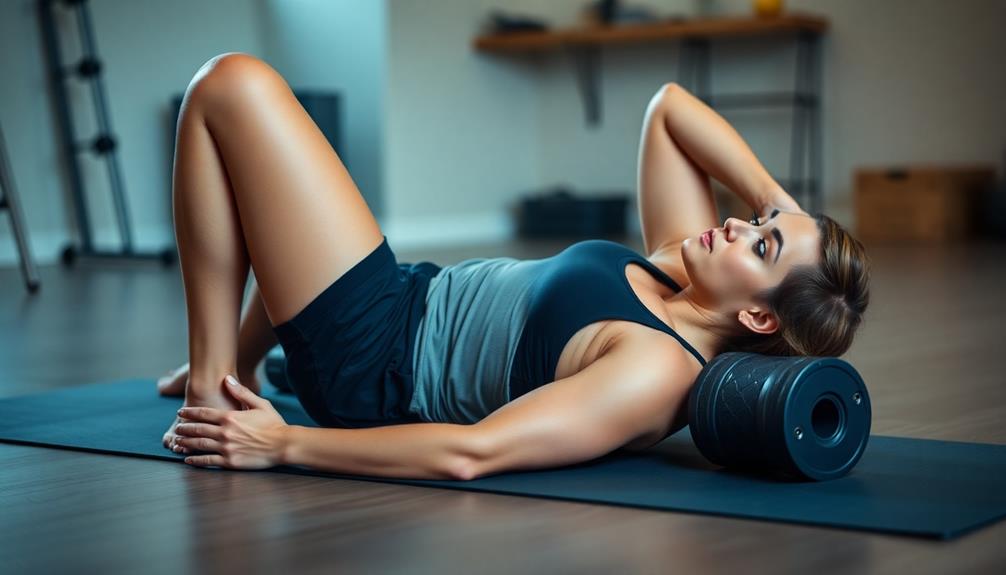
The IT band runs along the outside of your thigh. It can be hard to foam roll well. To do it right, lie on your side with the foam roller under your hip. Put your top leg in front for balance. Use your arms to slowly roll down your thigh to your knee. Firm foam rollers work best for this. They massage the IT band deeply.
As you roll, you might find tight spots. When you do, stop and hold pressure there for 20-30 seconds. Breathe deeply and try to relax. It might be a bit uncomfortable, but stop if it really hurts. After you've rolled the whole IT band, do it 2-3 more times. Make sure to roll both legs so they recover evenly.
Glute Targeting

After working on your IT band, it's time to focus on your glutes. These big muscles are important for leg day workouts and often need extra attention during recovery. Using the right foam roller can make a big difference in how well you target your glutes.
Sit on the foam roller, placing it right under your glutes. Cross one ankle over the opposite knee to work on each side separately. Slowly roll back and forth, focusing on any sore spots. When you find a tight area, stop and apply gentle pressure for 20-30 seconds.
To target different parts of your glutes, shift your body position slightly. Roll from the bottom of your glutes up towards your lower back, and then side to side. Work on both sides equally.
If you feel a lot of discomfort, use your hands to support some of your body weight and reduce the pressure.
Adductor Focus
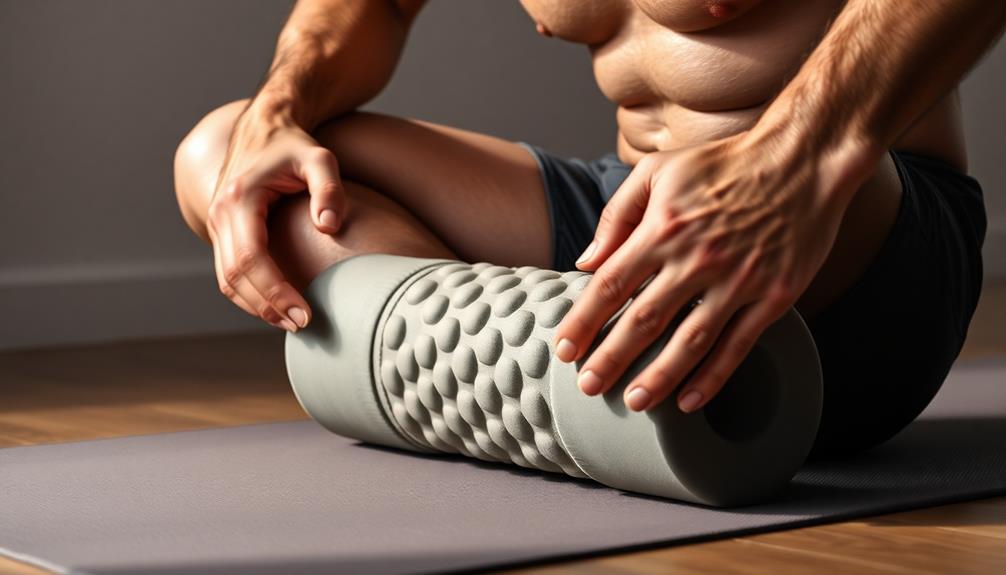
Adductors, the muscles on your inner thighs, are often overlooked but very important for leg stability and movement. To use a foam roller on your adductors:
- Lie on your stomach, one leg out to the side.
- Put the foam roller under your inner thigh, close to your groin.
- Slowly roll from groin to knee, stopping on tight spots.
A high-density foam roller works best for a deep tissue massage and relief of tight adductors. They stay in shape even with a lot of use.
Rolling might be uncomfortable at first, especially if you're new to it. This is normal. Take deep breaths and try to relax. If you find a really sore spot, hold the roller there for 20-30 seconds. This will help release tightness and make your adductors more flexible.
Shin Splint Prevention
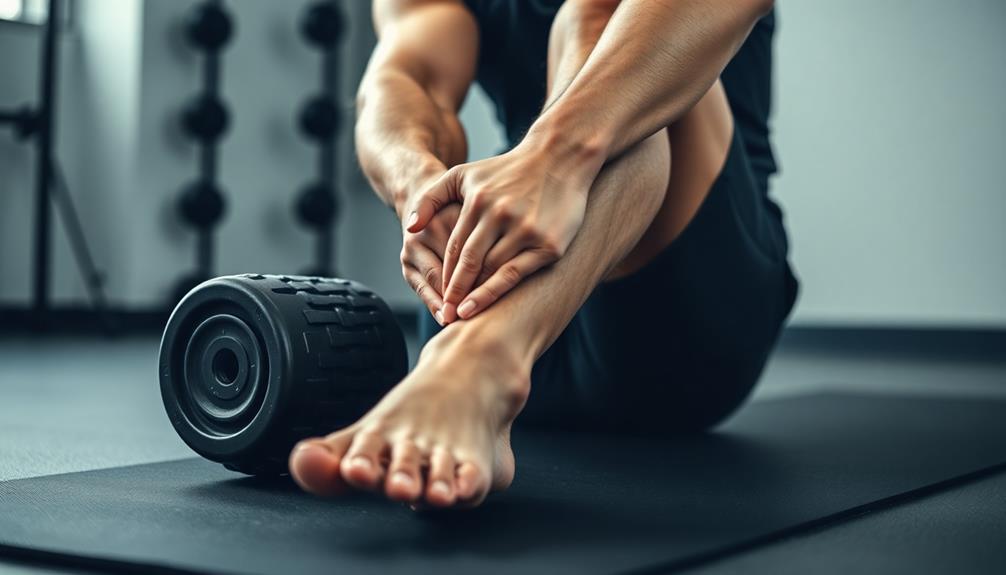
Foam rolling is a great way to prevent shin splints. It works on small muscles, not just big ones. To foam roll your shins, sit down and put the roller under your lower leg above the ankle. Use your hands to lift your hips, then slowly roll up to your knee. A firm, high-density foam roller works best for small areas like shins.
As you roll, you might feel sore spots. When you do, stop rolling and press on the sore area for 20-30 seconds. This helps relax the muscle and improve blood flow. Remember to breathe deeply and relax while foam rolling.
For the best results, foam roll each shin for 1-2 minutes. Do this after leg workouts to prevent shin splints and help your legs recover faster.
Lower Back Decompression

Foam rolling is a great way to relieve lower back pain after an intense leg workout. It can help relax your muscles and make you more flexible. Here's how to do it right:
- Get on your back and put the foam roller under your lower back.
- Bend your knees and keep your feet on the floor.
- Roll up and down slowly, paying attention to any sore spots.
Be gentle and don't press too hard. If it hurts, you're probably overdoing it. You can use a cold towel on your neck or forehead to cool down while you roll. Don't forget to breathe deeply and let your body sink into the foam roller. Foam rolling works well with other things you can do to recover after a workout.
Hip Flexor Massage
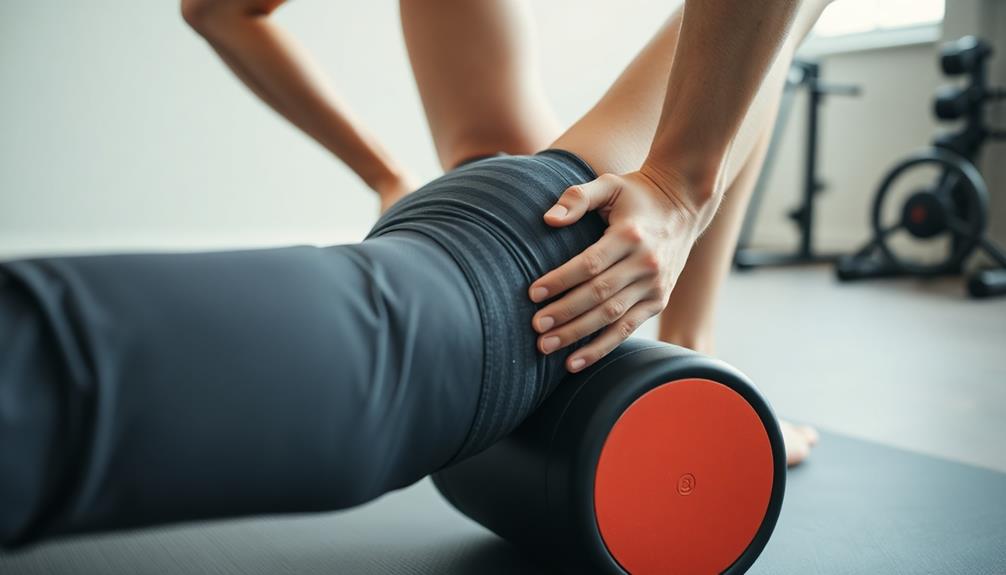
After working on your lower back, focus on your hip flexors next. These muscles often feel tight and sore after leg day. This can cause discomfort and make it harder to move around. To foam roll your hip flexors, lie face down with the foam roller just below your hip bone. Rest on your forearms for support. A firmer, high-density foam roller works best for tight hip flexors.
Go slowly as you roll towards your thigh. If you feel any tender spots, pause there. Gently press and hold for 20-30 seconds so the muscle can relax. For more pressure, put more of your body weight on the roller. Don't forget to take deep breaths as you roll.
Do this 3-5 times on each hip flexor. Rolling will help release tightness and improve flexibility in your hips.
Full Leg Integration
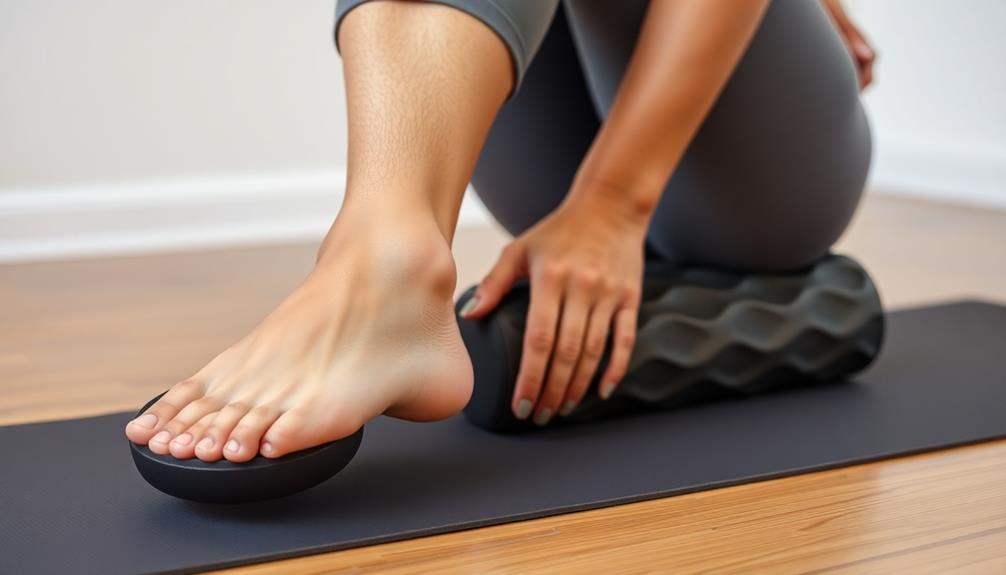
Finish your foam rolling routine by rolling out your entire leg. This improves blood flow and helps your leg muscles recover. A high-density foam roller works best for this.
Here's how to do it:
- Begin at your ankle and slowly roll toward your hip
- Keep steady pressure as you roll
- Briefly stop on any tight or sore spots
You'll feel how all your leg muscles connect as you roll. This final step releases leftover tension and balances your legs. Take deep breaths and relax while you do this last part.
Frequently Asked Questions
How Long Should I Foam Roll for Each Muscle Group?
You should foam roll each muscle group for about 30-60 seconds. If you find a particularly tight spot, spend extra time there. Don't overdo it; listen to your body and stop if you feel pain.
Can Foam Rolling Replace Stretching in My Post-Workout Routine?
While foam rolling can complement stretching, it shouldn't replace it entirely. You'll benefit most by incorporating both. Foam rolling loosens muscles and fascia, while stretching improves flexibility. Use them together for best post-workout recovery and mobility.
Is It Normal to Feel Pain While Foam Rolling?
It's normal to feel some discomfort while foam rolling, but it shouldn't be intense pain. You're working on tight muscles, so expect a bit of soreness. If it's too painful, ease up on the pressure you're applying.
How Often Should I Foam Roll During the Week?
You should foam roll 3-5 times a week, focusing on problem areas. Don't overdo it; listen to your body. If you're very active, you might benefit from daily rolling. Incorporate it into your warm-up or cool-down routine.
What's the Best Time to Foam Roll: Before or After Workouts?
You'll benefit most from foam rolling both before and after workouts. Pre-workout, it can increase flexibility and warm up muscles. Post-workout, it aids recovery by reducing muscle soreness and improving blood flow. Choose what works best for you.

